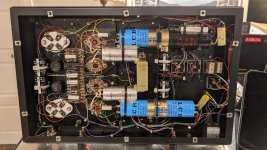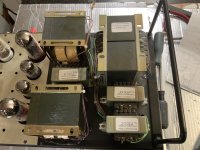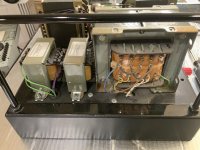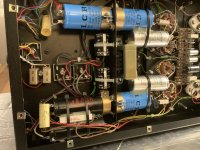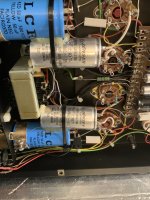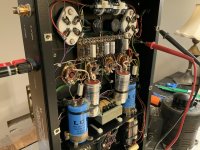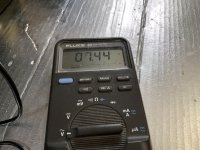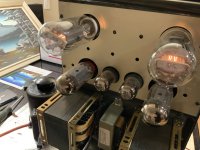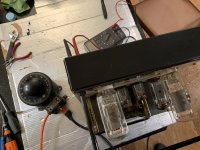I have an unusual Woodside triode power amplifier that started blowing fuse a while back. I put it away for 10 years and recently came across it in a move and would like to get it operating again. When it did run it was the best sounding amplifier I’ve ever heard, other than my even older Futterman OTL’s.
The company, while quite helpful, didn’t have much information as only a handful were made long ago. I have a TV-7D/U tube tester and a multimeter, and am pretty good with a soldering iron. I’ll begin by testing the signal tubes, but I have no parameters for the output tubes for my TV-7. The filaments have continuity.
I’m told the amp draws 4 amps from the power transformer… I hope it’s not shot.
Where should I begin after testing the tubes?

The company, while quite helpful, didn’t have much information as only a handful were made long ago. I have a TV-7D/U tube tester and a multimeter, and am pretty good with a soldering iron. I’ll begin by testing the signal tubes, but I have no parameters for the output tubes for my TV-7. The filaments have continuity.
I’m told the amp draws 4 amps from the power transformer… I hope it’s not shot.
Where should I begin after testing the tubes?
Attachments
That would be the filament current for one (1) output tube, assuming they are SV-811 tubes.I’m told the amp draws 4 amps from the power transformer…
jeff
Wired for 115VAC here in Canada, I think. I ran it this way for a long time.
Fuse is a T3.15AL 250V. I should get some slo-blo.
Fuse is a T3.15AL 250V. I should get some slo-blo.
Label on the amp says 300VA. That fuse seems too small. Try something more like a 5ASB fuse.
Do you know what fuse was in it originally? See if the PS schematic says anything about the fuse.
Other than the fuse itself, the other likely parts are the rectifier bridges, and the first capacitors following them.
Do you know what fuse was in it originally? See if the PS schematic says anything about the fuse.
Other than the fuse itself, the other likely parts are the rectifier bridges, and the first capacitors following them.
I don’t have the power supply schematic, so I don’t recall what was originally recommended.
I'll get some 5ASB fuses to try. Wouldn’t that be great if that’s all it is.
I recall something “clicking” just before it blew fuses.
i just called my local supplier and he said he “has a drawer full”. They close in 10 minutes, so stay tuned tomorrow.
it would be nice if I could at least check the test points for 70mV before the fuse goes, but we will see.
I'll get some 5ASB fuses to try. Wouldn’t that be great if that’s all it is.
I recall something “clicking” just before it blew fuses.
i just called my local supplier and he said he “has a drawer full”. They close in 10 minutes, so stay tuned tomorrow.
it would be nice if I could at least check the test points for 70mV before the fuse goes, but we will see.
Last edited:
Clicking could be HV arcing. Did you hear only one click, or several?
If you don't have the PS schematic, since that's the likely problem area, you'll have to generate one,
unless a member here has one. Do you know the model number of the amp?
Apparently Woodside was related to Radford at some point. However, this amp looks rather like a prototype.
If you don't have the PS schematic, since that's the likely problem area, you'll have to generate one,
unless a member here has one. Do you know the model number of the amp?
Apparently Woodside was related to Radford at some point. However, this amp looks rather like a prototype.
Last edited:
Chances are the filter caps are pretty tired and dried out. Some of the guitar amp guys aren't that impressed with LCRs. As far as I'm concerned, any electrolytic cap over 15 years old should be replaced. Just my two cents.
S.
S.
Yeah, it looks like one of those blue LCR caps has already been changed out to a JJ. And why is that sand cast resistor smothered in silicone?
jeff
jeff
Yes, it’s the Woodside SET 30. They are the company that replaced Radford. The nice fellow at Radford Revival, who makes new Radfords, had heard of it but has never seen one in person. I’ll be pleasantly surprised if anyone has a power supply schematic!Clicking could be HV arcing.
If you don't have the PS schematic, since that's the likely problem area, you'll have to generate one,
unless a member here has one. Do you know the model number of the amp?
Attachments
It came that way. There’s some other bodged silicone underneath. Whether it was a prototype from the start or someone experimented later is anyone’s guess.Yeah, it looks like one of those blue LCR caps has already been changed out to a JJ. And why is that sand cast resistor smothered in silicone?
jeff
Attachments
Last edited:
One click, as I recall.Clicking could be HV arcing. Did you hear only one click, or several?
If you don't have the PS schematic, since that's the likely problem area, you'll have to generate one,
unless a member here has one. Do you know the model number of the amp?
Apparently Woodside was related to Radford at some point. However, this amp looks rather like a prototype.
I’m back with some 5A slo-blo fuses. At 65 volts the filaments are starting to light, at least on the output tubes and the 6L6’s. I might need to turn it up more to get the 6SL7’s to light up. About 7.5 V AC at the test points but nothing yet on the mV DC scale. I believe I’m supposed to get 70 mV. Apply more voltage? Yikes!
Attachments
Last edited:
- Home
- Amplifiers
- Tubes / Valves
- Woodside Electronics SET-30 - Help!
